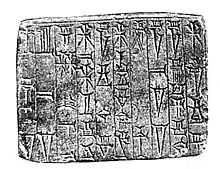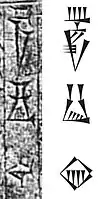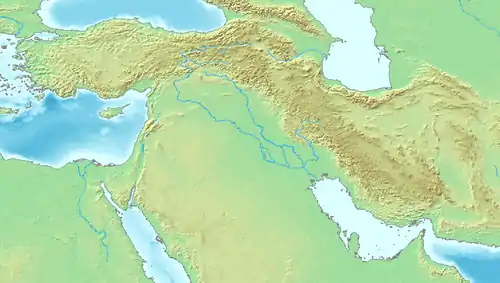Sîn-gāmil
Sîn-gāmil (inscribed in Akkadian: 𒀭𒂗𒍪𒂵𒈪𒅋: DEN.ZU-kà-mi-il)[4] was a king of Uruk during the 18th century BCE, at the time of the Isin-Larsa period. He was the son of Sîn-irībam, and Ilum-gāmil, his brother succeeded him.[5]
| Sîn-kāšid 𒀭𒂗𒍪𒂵𒈪𒅋 | |
|---|---|
| King of Uruk | |
 | |
| Reign | 18th century BCE |
| Predecessor | Sîn-irībam |
| Successor | Ilum-gāmil |
| House | 6th Dynasty of Uruk |
Sîn-gāmil is also known from one of this dedication tablets.[1]
His son was Salim-palih-Marduk, and, according to their seals, their deities were Marduk and Shamash.[6][4]
The dynasty of the Kings of Uruk in the 19-18th centuries BCE was composed of the following rulers in chronological order: Alila-hadum, Sumu-binasa, Naram-Sin of Uruk, Sîn-kāšid, Sîn-iribam, Sîn-gamil, Ilum-gamil, Anam, Irdanene, Rim-Anum, Nabi-ilišu, and an unknown king.[7]
.jpg.webp) The name "Sîn-gāmil" on a dedication tablet, and in standard Sumero-Akkadian cuneiform
The name "Sîn-gāmil" on a dedication tablet, and in standard Sumero-Akkadian cuneiform
References
- King, Leonard William (1910). A history of Sumer and Akkad : an account of the early races of Babylonia from prehistoric times to the foundation of the Babylonian monarchy. London : Chatto & Windus. p. 289.
- "Full description of the tablet: CDLI-Archival View". cdli.ucla.edu.
- BM 91082 "Tablet". British Museum.
- Tanret, Michel (2010). The Seal of the Sanga: On the Old Babylonian Sangas of Šamaš of Sippar-Jaḫrūrum and Sippar-Amnānum. BRILL. p. 165. ISBN 978-90-04-17958-5.
- Douglas Frayne (1990). Old Babylonian Period (2003–1595 B.C.): Early Periods, Volume 4. University of Toronto Press. pp. 439–483, 825.
- Toorn, K. Van Der (1996). Family Religion in Babylonia, Ugarit and Israel: Continuity and Changes in the Forms of Religious Life. BRILL. p. 67. ISBN 978-90-04-10410-5.
- "Year names (CDLI)". cdli.ox.ac.uk.
- "CDLI-Archival View". cdli.ucla.edu.
This article is issued from Wikipedia. The text is licensed under Creative Commons - Attribution - Sharealike. Additional terms may apply for the media files.
